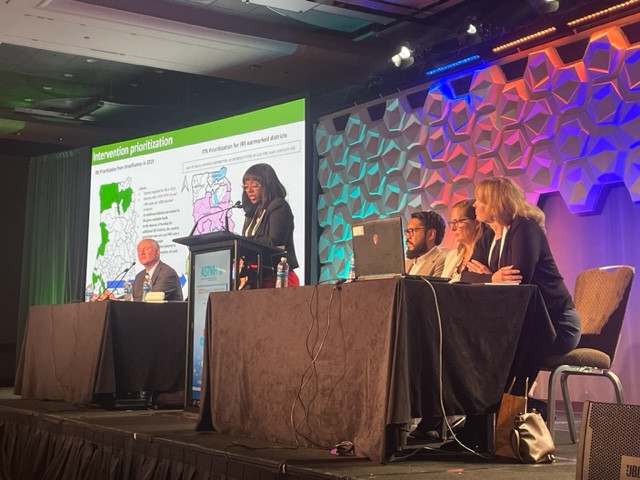ASTMH Annual Meeting 2025
blogFrom Insecticide Resistance to Outdoor Biting: The Many Challenges of Fighting Malaria by Fighting Mosquitoes
By: Matthew Davis, Burness

While targeting mosquitoes has proven to be enormously effective for dramatically reducing malaria deaths, a combination of insecticide resistance, pernicious shifts in mosquito behaviors, climate change and urbanization — along with the higher cost of addressing all of these challenges — is now posing a host of dilemmas for this essential component of the global malaria eradication campaign.
A panel of experts gathered Thursday at #TropMed23 to consider the current state of combatting malaria-carrying mosquitoes at the annual Alan J. Magill Malaria Eradication Symposium. The symposium honors the late Dr. Magill, a former ASTMH President who, as Malaria Director at the Bill & Melinda Gates Foundation, was an early advocate of embracing eradication as the ultimate goal of the global fight against the disease.
“Vector control is critically important for malaria elimination,” said David McGuire of the Innovative Vector Control Consortium. He noted that much of the progress against malaria burden in Africa has been accomplished via insecticide-treated bednets and indoor spraying campaigns. But he outlined a number of issues that imperil their efficacy. They include:
- Insecticide resistance: Mosquito resistance to the most widely used class of compound known as pyrethroids has prompted a switch to new compounds. But McGuire said mosquitoes still possess “some level of resistance” to these new compounds and that switching from pyrethroids generates higher costs for cash-strapped malaria control programs.
- Outdoor biting: The impact of bednets and indoor spraying has rested on the fact that most malaria infections occur when people are bitten indoors. But now a growing proportion of malaria infections involve mosquito bites outdoors, which McGuire said requires new solutions. Keziah Malm, Programme Manager for Ghana’s National Malaria Elimination Programme (NMEP), said experts in Ghana also are taking note of the fact that a different species of mosquito is involved in the shift to outdoor bites.
- Climate change: Mosquito-control campaigns are planned to coincide with the arrival of once-predictable rainy seasons. But McGuire noted that one impact of climate change is that rainy seasons are no longer predictable, making it hard to do the advanced planning.
- Urbanization: While the malaria burden was once mainly concentrated in rural communities, the rapid population shift to urban areas requires developing tools and strategies that are appropriate for these settings.
- Competition for malaria control finances: The battle against malaria-carrying mosquitos is occurring in the context of a world where new tools are arriving on all fronts. McGuire said that along with new insecticides, new drugs and vaccines are becoming available. He said that this challenges people leading national and global malaria control programs — all of which are underfunded — to identify the best mix of tools that will give them the best results for the money.
Malm, with the Ghana program, said there are constantly new variables emerging. For example, she noted that efforts to use larvicides to control mosquito breeding in water sources must account for potential impacts to organic farming, which is becoming increasingly popular in Ghana.
Gabriel Carrasco-Escobar, with the Institute of Tropical Medicine at the Universidad Peruana Cayetano Heredia in Lima, Peru, encouraged a greater usage of imagery from both satellites and drones to help guide more targeted mosquito control efforts. He said high quality imagery now available from both sources can be analyzed with new tools to capture natural and human changes to the landscape that create ideal conditions for intensifying mosquito populations. Carrasco-Escobar said these insights can be augmented with data crowd-sourced from mobile phone apps that can detect mosquito densities by capturing their sounds.
Ultimately, keeping track of the zigs and zags of malaria-carrying mosquitos will require entirely new ways of stopping the insects from injecting parasites via their bites. Flaminia Catteruccia of the Harvard T.H. Chan School of Public Health is particularly interested in strategies that would prevent mosquitos from transmitting malaria parasites without affecting the mosquito itself. She noted that the key advantage is that, unlike insecticides, they would not put pressure on mosquito survival, which encourages the development of resistance.
She reviewed several innovations that are being explored, including:
- Compounds that shorten the life span of mosquitos, limiting their opportunities to incubate and transmit malaria parasites but without killing them.
- Using bacteria that can spread through mosquito populations that prevents parasite transmission. Catteruccia said recent efforts have identified one type of bacteria that appears promising. But she noted that a different type of bacteria, known as Wolbachia, which that has been effective for preventing the spread of mosquito-borne viruses like dengue, is not effective for mosquitoes that carry malaria.
- Developing and releasing mosquitos with genetic modifications that eliminate malaria parasites in their guts. Catteruccia contrasted this approach to other efforts focused on releasing mosquitoes modified with a gene that interferes with reproduction.
- Developing bednets that, instead of insecticides, would be infused with medications known to kill malaria parasites.
Helen Jamet, deputy director of vector control at the Bill and Melinda Gates Foundation, said the fresh thinking on vector control on display at the symposium was an apt tribute to Magill’s legacy.
“Alan was willing to take risks and conduct pilots to determine what worked and what did not work,” she said. “We have to do the same (with vector control).”
Related Posts
By: Matthew Davis, Burness